Because of the baffling number of tree-climbing lions in the Ishasha Sector, a highly unique feature and one of the main highlights of Uganda safari tours for which the majority of visitors come to this park nowadays. 130 of Uganda’s 400 or so lions are located at Queen Elizabeth National Park. The park is notable for its spectacular terrain, which includes the Maramagambo woodland, Kazinga Channel, craters, and Kyambura Gorge, as well as its abundant birdlife and wildlife, particularly the uncommon tree-climbing lion.
You will be able to enjoy viewing these enormous cats as you drive through the Park since tree-climbing lions have a unique build and while they lounge around the trees. In addition to watching the little animals that move around the park and digesting their food, lions can often be observed lounging in trees planning their next kill. There are extremely few adult tree-climbing lions. Once they reach a particular size, most lions stay away from trees, except in situations where climbing a tree is the only safe alternative, like when they are encircled by a herd of buffalo.
Where can you see tree-climbing lions?
Lions that can climb trees can be found primarily in Tanzania’s Lake Manyara National Park and Uganda’s Queen Elizabeth National Park’s Ishasha region. In the Serengeti National Park in Tanzania and the Kruger National Park in South Africa, specific lions have also been seen scaling trees. These sightings, however, are few and cannot be compared to those in Lake Manyara or Queen Elizabeth National Park. The finest area to see tree-climbing lions in Queen Elizabeth National Park since an entire pride can be seen in Ishasha. It is more challenging to find and not always possible to find the tree-climbing lions in Lake Manyara.
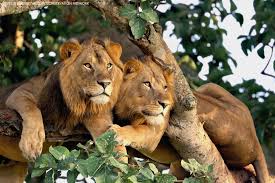
Uganda takes pride in having one of just two tree-climbing lion populations in the entire world. The worldwide renowned tree climbing lions have their home in the Ishasha section of Queen Elizabeth National Park, which is about 432 kilometers southwest of Kampala, the capital of Uganda. Only two populations of these lions exist worldwide, and they regularly climb trees as part of their daily activities. For the majority of visitors to this park, the puzzling colony of tree-climbing lions has been the main attraction.
Have you ever imagined what a lion looks like perched on a tree? Your query and curiosity are both answered by Queen Elizabeth National Park. Along with the more mature lions, you will be able to watch the youngsters playing and hanging from tree branches. As is common knowledge, lions rarely climb trees; the ones at Queen Elizabeth Park are an exceptional instance.
Why do they climb trees?
In Queen Elizabeth National Park, lions climb sycamore and acacia trees that contain figs. These lions only climb the trees after sunrise, not before. The lions lounging on the tree can be captured on camera and in films. This is due to the trees’ ability to offer adequate cover throughout both the wet and sunny seasons.
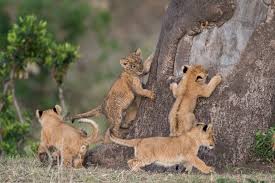
The Lions, whose primary prey are the countless Uganda Kobs that graze in the wide-open Ishasha plains, are typically observed lounging up on the branches of the enormous fig trees and gazing down at them. The Sycamore Fig and Acacia trees are beautiful because they offer the tree-climbing lions enough cover that it can often be difficult to see them from a distance. In addition, they serve as a shelter during the rainy season and are thick enough to support the lions.
The perspective from the top of the trees allows the lions to spot the varied preys that can be spotted skulking around the Park. These large cats can attack their prey without being seen.
To escape the heat of the earth and find cover from the rain, they climb trees. Since 28 degrees is a possibility and is unsuitable for cats, they ascent in trees to escape too much heat.
The large branches of the trees, which can accommodate the cats, make them an ideal spot for them to relax after a tiring day of hunting. The tsetse flies, which prey on animals, especially during the wet season, are protected from the lions by the trees.
Therefore, if you ever find yourself being pursued by a lion, trying to flee by climbing up into the trees won’t do you much good, especially in Queen Elizabeth National Park where lions can climb up into the trees. In reality, they frequently spend the afternoons dozing off on branches as they finish lunch.
The best time to visit the Ishasha sector
Visitors on a Uganda safari can explore Queen Elizabeth National Park and the Ishasha region at any time of year. In Uganda, the dry season (April, June, and July) is thought to be the busiest time for travelers. The park is less soggy and the lions are simpler to find during this time of the year making it ideal for a safari. The rainy seasons, which are May, October, and November, are best for bird watching. If you wish to explore these beautiful animals along with gorilla trekking in Bwindi or a safari tour to Rwanda, then take a look at our Uganda Wildlife safari package.
How to get there
Ishasha, the home of the tree-climbing lions, offers isolation for those with their vehicles. The path from Katunguru might not be trustworthy. The direct route to the Ishasha border station, however, is typically covered in mud during the rainy season. It is more appropriately referred to as a seasonal route and calls for 4×4 wheel vehicles.
If you are traveling from Mweya, it’s advisable to ask the park office there to send a radio message to the Ishasa Katookye gate inquiring as to whether any trucks are moving from the Katunguru course. You can use this to determine whether the road is passable.
Even though the road is regularly maintained, it only takes a little rain to seriously damage its surface, causing a truck to get stuck to cause delays or even force a diversion through Kihihi, Isaka, and Rukungiri which are more reliable.
Where to stay in the Ishasha sector
Although there are several good accommodation facilities available for visitors within Queen Elizabeth National Park, the ones in Ishasha are few. Booking in advance with your tour operator in Uganda is highly recommended, especially during the peak seasons like June. Let’s look at two of the more popular lodges in Ishasha.
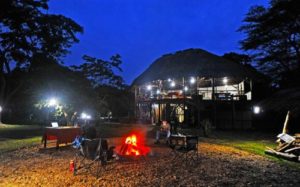 Bull bush river camp: The Queen Elizabeth National Park’s Bull Bush River Camp is a basic yet serene resort that provides its visitors with an outstanding experience right in the middle of Ishasha. The camp has four cottages with bathrooms and two family rooms, all of which have stunning views of the river and the Queen Elizabeth National Park’s adjacent riverbank. They have distinctively designed cabins, delectable home-cooked meals, a swimming pool, and the ideal circumstances for observing over 1,000 species of animals, including birds, monkeys, elephants, and tree-climbing lions. Accessing Queen Elizabeth National Park is only a few minutes away from the camp.
Bull bush river camp: The Queen Elizabeth National Park’s Bull Bush River Camp is a basic yet serene resort that provides its visitors with an outstanding experience right in the middle of Ishasha. The camp has four cottages with bathrooms and two family rooms, all of which have stunning views of the river and the Queen Elizabeth National Park’s adjacent riverbank. They have distinctively designed cabins, delectable home-cooked meals, a swimming pool, and the ideal circumstances for observing over 1,000 species of animals, including birds, monkeys, elephants, and tree-climbing lions. Accessing Queen Elizabeth National Park is only a few minutes away from the camp.
Enjojo Lodge: To create the impression that guests are in the African wilderness, Enjojo Lodge was constructed using indigenous materials and offers both mid-range and premium amenities. Every decoration is made by regional artists, many of whom are from adjacent towns. The cottages provide sufficient comfort to let you unwind while you anticipate the sector’s activities the following day. Residents of the resort can see animals wandering around freely on the property and Fishing for tilapia and lungfish in Lake Akanyanza is one of the activities accessible to residents of the lodge.
Ishasha Wilderness Camp: Travelers who want to get close to nature and learn what it’s like to live among the untamed bushes of Africa should stay at this resort. The camp is situated in a rural, largely undeveloped location along the banks of the River. The tents’ riverside location allows guests to observe various park inhabitants, including elephants, hippos, antelopes, and small primates, as they bathe and drink along the banks. Vervet and Colobus monkeys frequent the camp and are frequently spotted swinging from neighboring trees in the vicinity of the compound. Meals are available to be served in the rooms or a gorgeously decorated dining area on the riverbanks. Residents have the opportunity to get together at the camp and discuss their experiences from the entire day spent on the Ishasha plains.

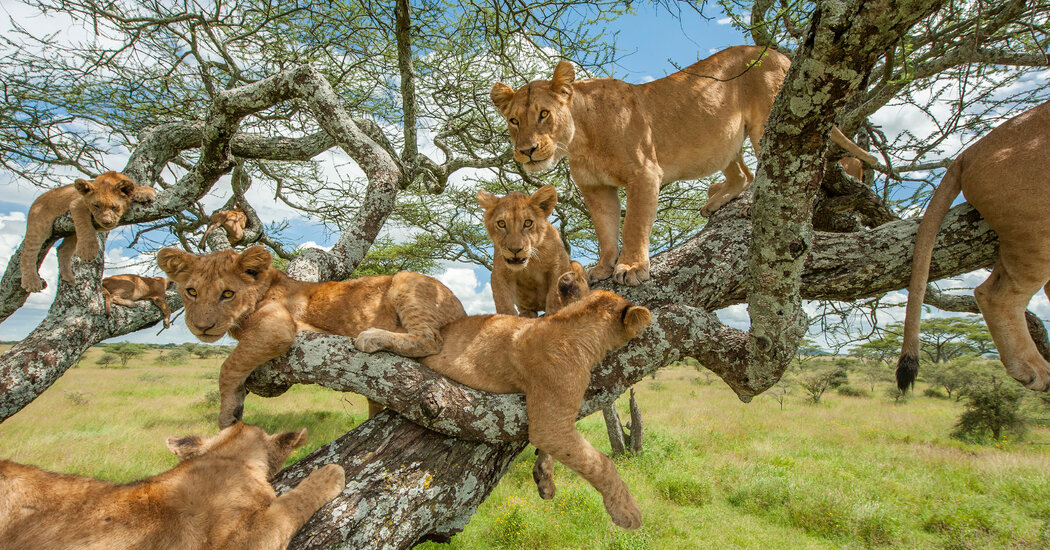
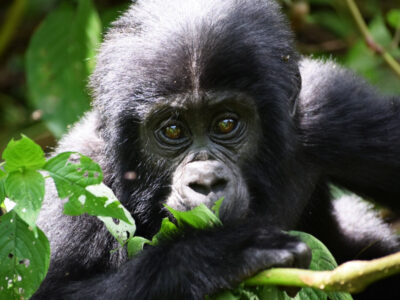
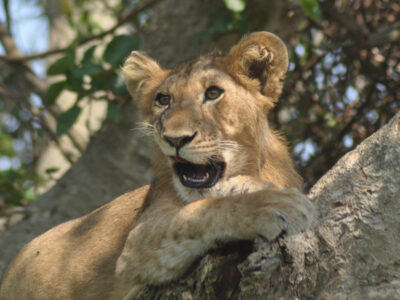
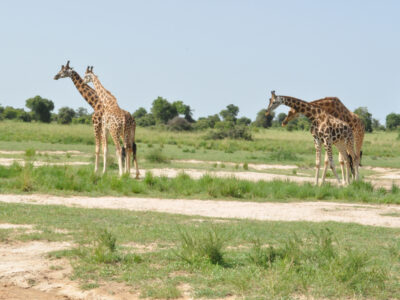
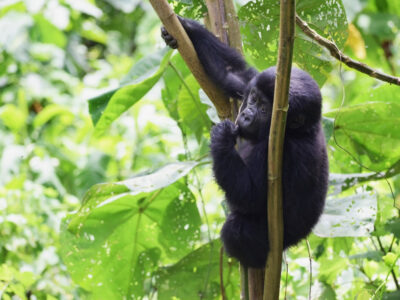
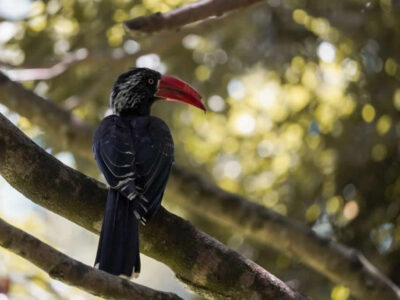
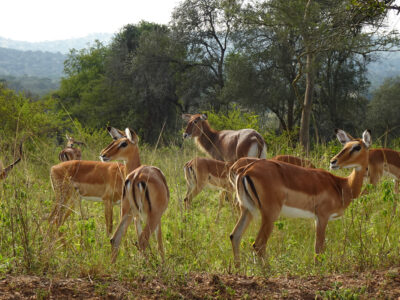
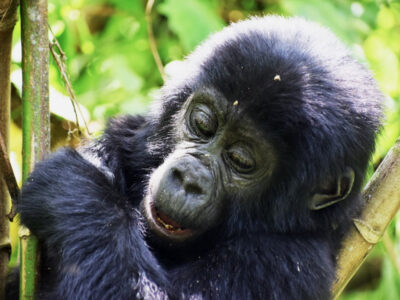
2 Replies to “Tree-climbing lions of Ishasha sector in Queen Elizabeth National Park”